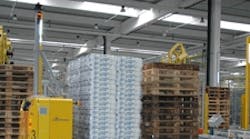Many high-volume food processing plants are facing a growing logistics challenge—handling a growing variety of food products with different primary and secondary packaging. It is getting more difficult for food processors to maintain high efficiency while coordinating end-of-line pallet building with pallet movement into storage or shipment.
These challenges are amplified by the impact of rising labor costs, increasingly strict safety regulations, and the need to maintain acceptable food industry standards for cleanliness.
Let Me Count the Inefficiencies
Most high-throughput food processors have advanced their filling and primary packaging equipment to embrace highly efficient operations, and downstream have equipped their warehouses with automated storage and retrieval systems (ASRS), automated guided vehicles (AGVs) and picking systems to improve throughput. But between these two operations, many food manufacturers are plagued by inefficient end-of-line pallet building and pallet transport systems.
Most conventional end-of-line pallet handling is based on conveyors linking carton packers with palletizers, stretchwrappers and labelers, then with the warehouse or shipping, supported by manually-operated lift trucks.
Pallet conveyors are limited by how much they can be adjusted to accommodate changing throughput requirements. Additionally, they limit free and available space for maneuvering and load staging in the end-of-line environment.
In food processing plants, sanitation is always a factor. Although end-of-line pallet handling conveyors may not be located in areas of the plant where food is directly being processed, product spillage is a concern.
When it does happen, throughput is slowed and can even stop the line. Many manufacturers have their pallet conveyors rated for wash-down or heavy wash-down as a better guarantee to recover the line in the event of a product spillage.
Chilling Productivity
One of the major causes of food product damage, misdirected orders and facility damage in food plants is from lift trucks moving pallet loads through the end-of-line and warehouse operations.
This is nowhere more evident than in the handling of chilled and frozen food products, which pose challenges for food processors whose facilities must operate efficiently.
Maintaining a high throughput rate along with fulfillment accuracy at -18.4° F is more difficult and costly than in ambient temperatures.
Chilled and sub-zero facilities have a higher incidence of product damage and wrong-item fulfillment.
Personnel turnover in chilled and cold facilities is also higher than in ambient temperatures. While the temperature in these facilities is cold enough to maintain food product safety, it creates an extreme environment with difficult working conditions for personnel, more safety issues, and personnel recruitment and retention problems.
Today, a producer of food products needs to track and identify each pallet—where it came from, where it was stored, what the temperature was in storage, and other critical data to keep track of perishable inventory and ensure product integrity. Manual end-of-line pallet handling leaves open the possibility of human error, and with many manufacturers, is responsible for the biggest error points in shipping.
Robotic Palletizing
Fully-automated robotic palletizing equipment, coupled with a flexible and mobile pallet transport system, can be linked to upstream processes and ERP, as well as downstream warehouse and shipping equipped with real-time load tracking and verification. Such a pallet building and movement system can integrate various automated end-of-line processes.
One such system, the Freeway, manufactured by Elettric 80, combines robotic palletizers, laser-guided vehicles (LGVs), labeling equipment, product tracking software and a PC-based monitoring system.
Robotic palletizing cells handle goods and optimize pallet loads at the end of the production line. LGVs transport the pallets to high-speed stretch-wrapping and labeling equipment, and then to storage, or staging on the floor to await shipping.
Smart Laser Guided Vehicles
An LGV system is comprised of one or more vehicles that move around predetermined routes to perform transport functions as directed by a stationary control system. They are equipped with navigation systems, based on laser guidance, which allows the LGVs to be free roaming within the end-of-line system layout.
The latest generation of LGVs can lift pallets up to 36 feet high for positioning in racked storage or floor staging. This can reduce rack damage caused by lift truck operators. It can also reduce energy costs as the LGVs can operate in an un-lit environment.
The LGVs can move at five feet per-second and carry multiple full pallets at a time, including ambient temperature, chilled and frozen products combined in unit loads.
An obstacle detection system helps LGVs detect anything in their path in sufficient time so that the units can slow down and stop if necessary. Once the path is clear, the LGVs will automatically continue their trip. The system is designed to handle high-volume pallet movements in a 24/7/365 operation.
System Controls
The controls system coordinates orders received from the plant’s process system or ERP, and warehouse and shipping, and then directs the work for the LGVs.
The controls manage the system’s operation, including management information, load prioritization, load status, productivity statistics and reports, and workload analysis.
Associated functions can also be automated, such as case stacking in the robotic palletizers, empty pallet inspection and delivery, finished pallet transport, finished pallet stretch-wrapping, finished pallet labeling, and finished pallet transport to storage or shipping. Windows and SQL database architecture enable a single platform.
Positional status is continuously updated through the controls system at least once per second, indicating whether an LGV is loaded or unloaded, emergency stopped or soft stopped, operating in manual mode and battery level. A simulation module simulates the LGVs in the system. A human/machine interface (HMI) gives the operator a graphical overview of the LGV locations in the system and monitors each in real-time.
The system’s controls monitor and guide the complete end-of-line pallet handling process, and help users meet the food sectors’ special requirements for hygiene, safety and data tracking.
Jim McMahon writes on logistics automation. He can be reached at [email protected].



